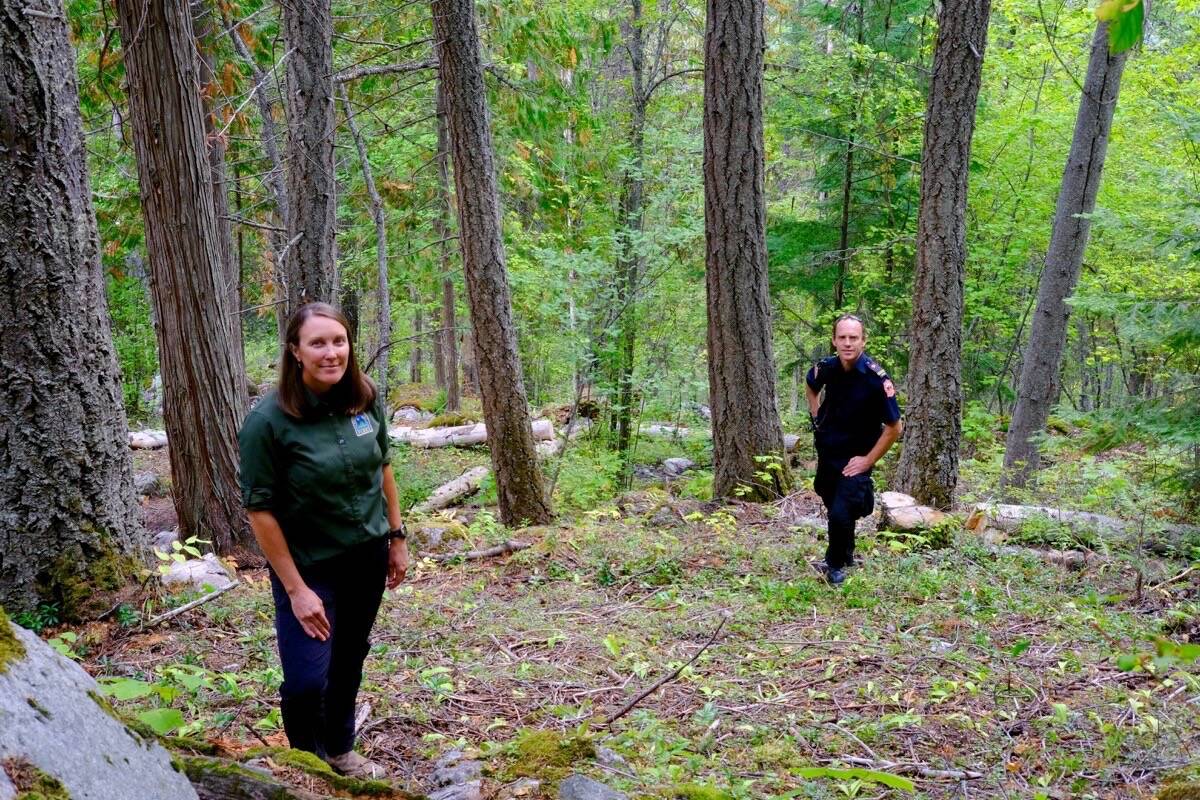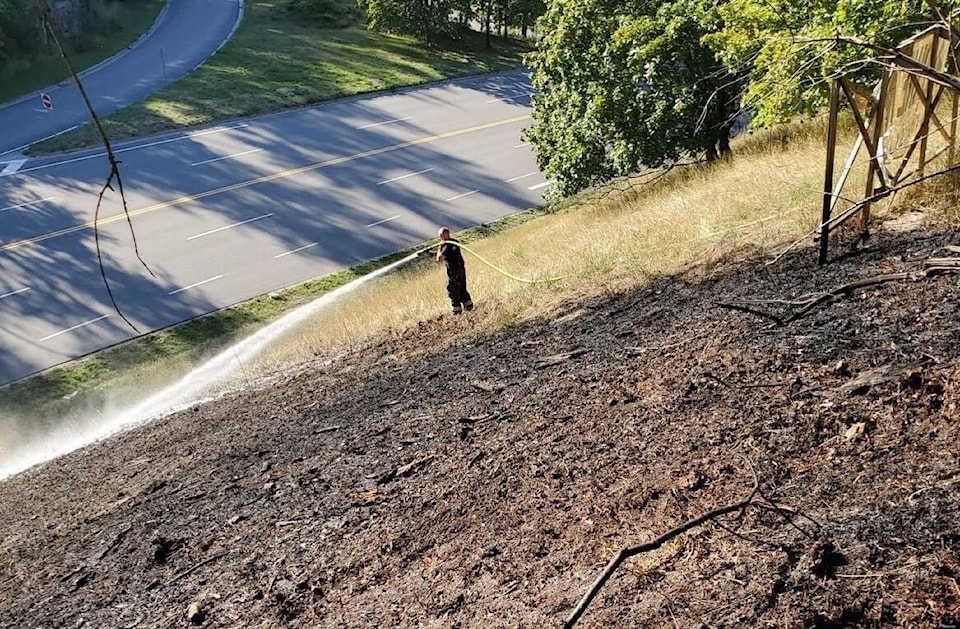The City of Nelson’s emergency management co-ordinator says the city has done a lot to reduce the risk of wildfire destruction of the city, but it’s not enough.
Len MacCharles, who is also the city’s fire chief, says Nelson has not kept up with the increasing danger posed by climate change.
“Extreme circumstances require extreme thought processes,” said MacCharles at a council meeting on Oct. 29.
He provoked a wide-ranging discussion at the council table about how the city must think outside the box when it comes to protecting itself from wildfire.
He said the 2021 fire season had a dangerous mix of elements: the heat dome, mid-summer drought, six major wildfires in the Regional District of Central Kootenay, 750 properties in the RDCK on evacuation order, 1,200 properties on alert, long periods of dangerous levels of smoke, concerns about the city running out of water, and generalized community anxiety about the smoke and heat.
MacCharles said the city should re-think its practices regarding landscaping, building, and water supply, keeping in mind that the city is still at the mercy of other agencies and landowners outside the city.
Landscaping: don’t plant cedars
MacCharles reminded the councillors that most towns damaged by wildfires are ignited by embers landing on flammable materials including coniferous trees. He said airborne embers can travel up to two kilometres.
Homeowners and landscapers should not be planting cedars or junipers, and nurseries should not sell them, he said, because they are so flammable.
MacCharles called any decision to plant cedars in Nelson “ridiculous.”
Council speculated on whether a future bylaw could outlaw certain trees, noting that it would have to be limited to new homes. They discussed whether a no-cedars rule could be enforced retroactively for existing homes.
In 2019, council adopted a bylaw prohibiting the planting of coniferous trees within 1.5 metres of new and existing houses. Mayor John Dooley said at the time that the success of this bylaw would depend on education, because it is difficult to enforce.
Building materials: say no to cedar and vinyl
MacCharles said no one should be allowed to build a house with vinyl or wood siding or cedar shakes. He said the city needs to learn more about the fire ratings of various other materials.
A current city bylaw states that such materials may not be used on new homes in Development Permit Area 3, which is the outermost part of the city that borders on forests, a small fraction of the area of the city.
Dooley pointed out that to build a deck less than one metre above the ground, a building permit is not needed, and so the materials are out of the city’s control.
MacCharles said vinyl siding melts in a wildfire, exposing the underlying wood structure to the flames.

FireSmart assessments: should they be mandatory?
The fire department has conducted free FireSmart assessments for Nelson homeowners for the past seven years.
“We go out to people’s homes, walk around with them, and say, ‘Hey, this is looking good, this is not looking so good, this firewood has to be moved, and this juniper bush you have right against your basement window is going to catch on fire, bust the window, and burn the house.’”
One of the most commonly discovered dangers is the location of coniferous trees near houses. According to national FireSmart principles, there should be nothing flammable within 1.5 metres of a building.
“It is not a matter of if you get an ember shower, it is when,” MacCharles said. “There will be buildings burning. I have seen this first hand (elsewhere) and that is the way it does happen.”
MacCharles said about 400 to 500, or about 10 per cent, of Nelson’s homes have had a voluntary FireSmart assessment, but this does not necessarily mean the homeowners have followed up on the advice given.
The number of assessments has fallen off sharply in the past two years.
MacCharles recommended a rebate program in which $500 could be given to homeowners for following up on actions recommended in a FireSmart assessment.
Councillor Keith Page said the city should consider making FireSmart assessments mandatory, after a grace period of a few years to give people a chance to do it voluntarily.
He said the city can not wait for the insurance companies to force compliance. MacCharles agreed, saying, “They have been extremely slow in making decisions or policies that would help (to motivate homeowners to fire-proof their properties).”
MacCharles said that in the past few years the city has cleaned up flammable debris on 25 individual city-owned sites, collaborated with B.C. Parks in doing similar work within West Arm Park and at the city water intake, introduced a new water source at Selous Creek, and passed the planting and building bylaws mentioned above.
He said wildfire mitigation work — creating shaded fuel breaks in the forest or cleaning up sites in the city — are all dependent on provincial government grant funding.
MacCharles said private landowners outside the city pose a danger because they are not obliged to remove dangerous fuel from their forested properties.
MacCharles said there were two serious grass fires within the city limits this year — one on the highway interchange and the other on CP Rail land, both human-caused, and both on days with no wind. The fires could have consumed the city if there had been a wind, he said.
Council decided to find ways to reduce the risk of fire on the highway interchange in collaboration with Ministry of Transportation and Infrastructure.

Water supply: revisiting Kootenay Lake
MacCharles said the extreme drought this past summer not only increased the wildfire risk but dramatically decreased the water supply.
In council’s discussions over the years about how to increase the water supply to Nelson’s reservoir at Mountain Station, the possibility of using Kootenay Lake water has been dismissed because of the high cost of pumping water such a long distance uphill.
Instead, council has focused on finding and improving sources that could arrive at the reservoir by gravity feed, such as the recent addition of Selous Creek water to the system.
But this approach may be changing.
“If we lose Five Mile Creek (Nelson’s main water source),” city manager Kevin Cormack said at the Oct. 29 meeting, “the possibility of pumping water out of the lake in case of wildfire is something we need to be looking at.”
Sprinklers on every roof?
Council also discussed what it would take to have sprinklers on the roof of every house in Nelson, or to have water cannon, hoses, or sprinklers along the rail trail.
“They create a humidity bubble and they work, but if you can imagine, if we had 4,000 houses with two sprinklers on each, that’s a lot of water that will go pretty quickly,” MacCharles said. “I think given that we have had such extreme wildfire season and drought heat in past five years, we need to explore that.”
Related:
• Nelson fire department releases FireSmart videos
• Man arrested after Nelson grass fire
• Completion of Selous Creek line improves Nelson’s water supply
• Nelson at highest risk for wildfire, expert says
• Nelson creates rules for wildfire resistant landscaping and building
• Nelson fire department cleans up urban wildfire fuel on city property
• Action by Nelson area landowners key to wildfire safety, expert says
.
bill.metcalfe@nelsonstar.com
Like us on Facebook and follow us on Twitter
